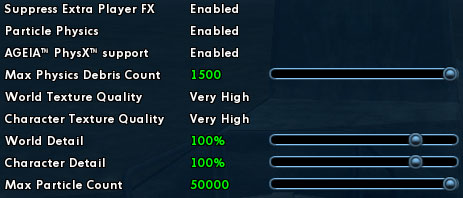PhysX Performance Update: City of Villains
by Ryan Smith on September 7, 2006 6:00 AM EST- Posted in
- GPUs
The last time we took a look at physics performance under City of Villains utilizing a PhysX card, the code was still in beta, and the results for the PhysX card were lackluster at best. What we found was that while utilizing a PhysX card did indeed enable CoV to generate a good deal of extra eye-candy, the cost came at an immense performance drop, especially to minimum framerates. At the time, AGEIA had promised that performance under CoV would improve between then and when the improvements were actually put into the Issue 7 patch. That patch has since shipped, and we are back to take a look at just what the PhysX card is capable of doing given more refined code.
Since the beta version of Issue 7 was in testing, Cryptic has also made several changes to CoV to better allow benchmarking, as previously FRAPS was the only way to do a repeatable test using higher physics settings. The CoV's benchmark mode now properly renders additional physics based on the game's settings, allowing for more controlled testing and more importantly testing against the live server where we can no longer copy characters. Also, the highest physics mode, previously only allowed with PhysX hardware installed, now can run completely under software, giving true apples-to-apples testing where all physics effects are the same.


This later point is particularly important, since AGEIA was able to confirm a few earlier theories we had on the game. In the highest quality mode (various physics modes have replaced the items slider), both the hardware and software physics engines end up doing the same physics routines with the same precise formulas. Meanwhile, in any of the lower quality modes the software engine is allowed to make approximations in return for the faster calculations, and at the lowest quality settings the software mode renders fewer overall effects. We'll look at how the various settings affect the performance and visual quality under CoV, so keep in mind that only the maximum quality mode is identical for both software and hardware physics.
Dual core performance is also something that has seen some changes since the Issue 7 beta, as the game is now capable of doing physics calculations on a separate core. As we'll see in a second, the game benefits tremendously from a second core, which may not be in AGEIA's best interests.
What does all of this mean for physics performance then under CoV? Let's take a look.
Since the beta version of Issue 7 was in testing, Cryptic has also made several changes to CoV to better allow benchmarking, as previously FRAPS was the only way to do a repeatable test using higher physics settings. The CoV's benchmark mode now properly renders additional physics based on the game's settings, allowing for more controlled testing and more importantly testing against the live server where we can no longer copy characters. Also, the highest physics mode, previously only allowed with PhysX hardware installed, now can run completely under software, giving true apples-to-apples testing where all physics effects are the same.


This later point is particularly important, since AGEIA was able to confirm a few earlier theories we had on the game. In the highest quality mode (various physics modes have replaced the items slider), both the hardware and software physics engines end up doing the same physics routines with the same precise formulas. Meanwhile, in any of the lower quality modes the software engine is allowed to make approximations in return for the faster calculations, and at the lowest quality settings the software mode renders fewer overall effects. We'll look at how the various settings affect the performance and visual quality under CoV, so keep in mind that only the maximum quality mode is identical for both software and hardware physics.
Dual core performance is also something that has seen some changes since the Issue 7 beta, as the game is now capable of doing physics calculations on a separate core. As we'll see in a second, the game benefits tremendously from a second core, which may not be in AGEIA's best interests.
What does all of this mean for physics performance then under CoV? Let's take a look.










31 Comments
View All Comments
Lonyo - Thursday, September 7, 2006 - link
£107 for an X2 3800+ or £187 for a PhysX accelerator.I think I made the right choice upgrading from a single core to dual core.
It's nice to see there are some improvements, but money is almost always better spent elsewhere, like with the Killer NIC.